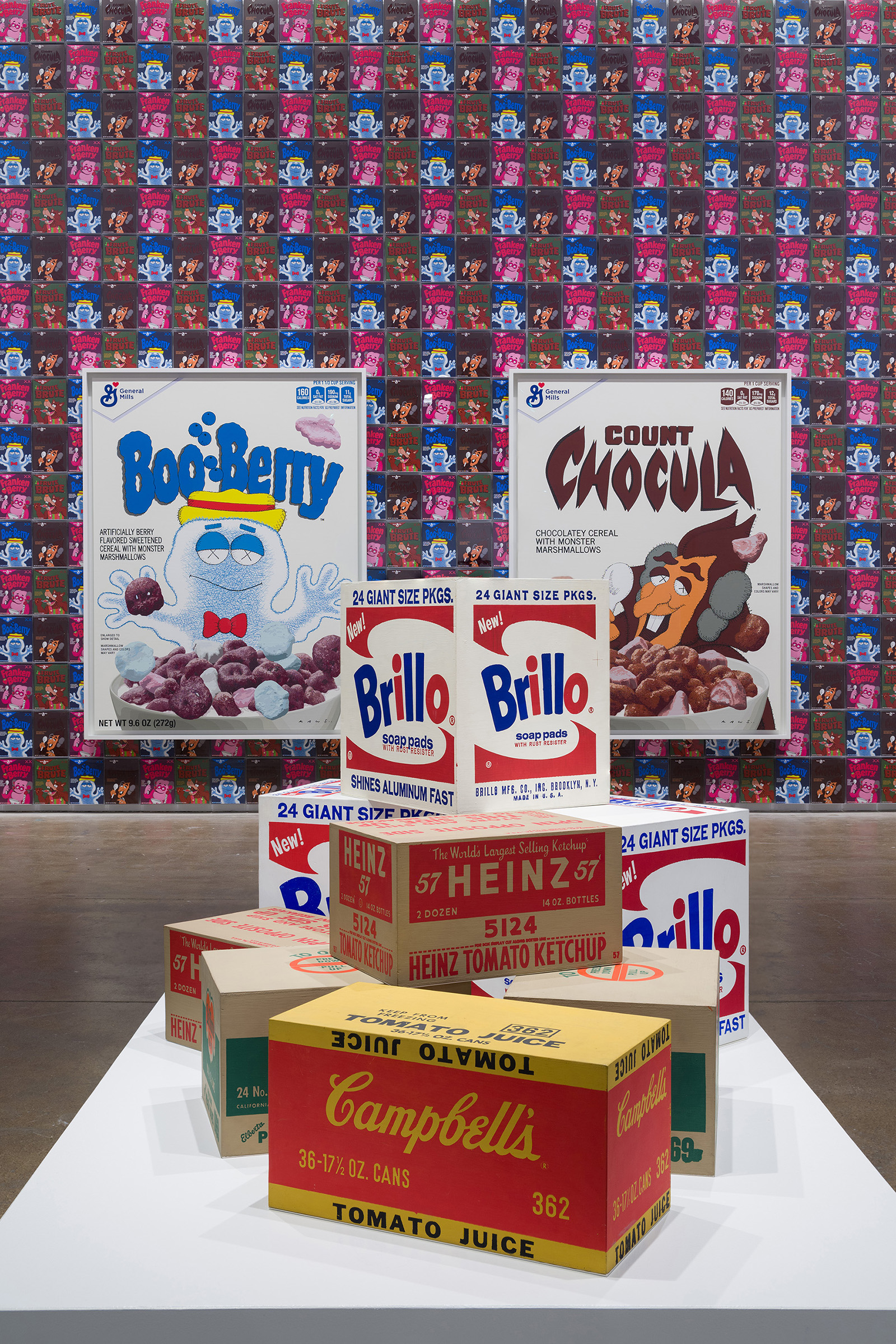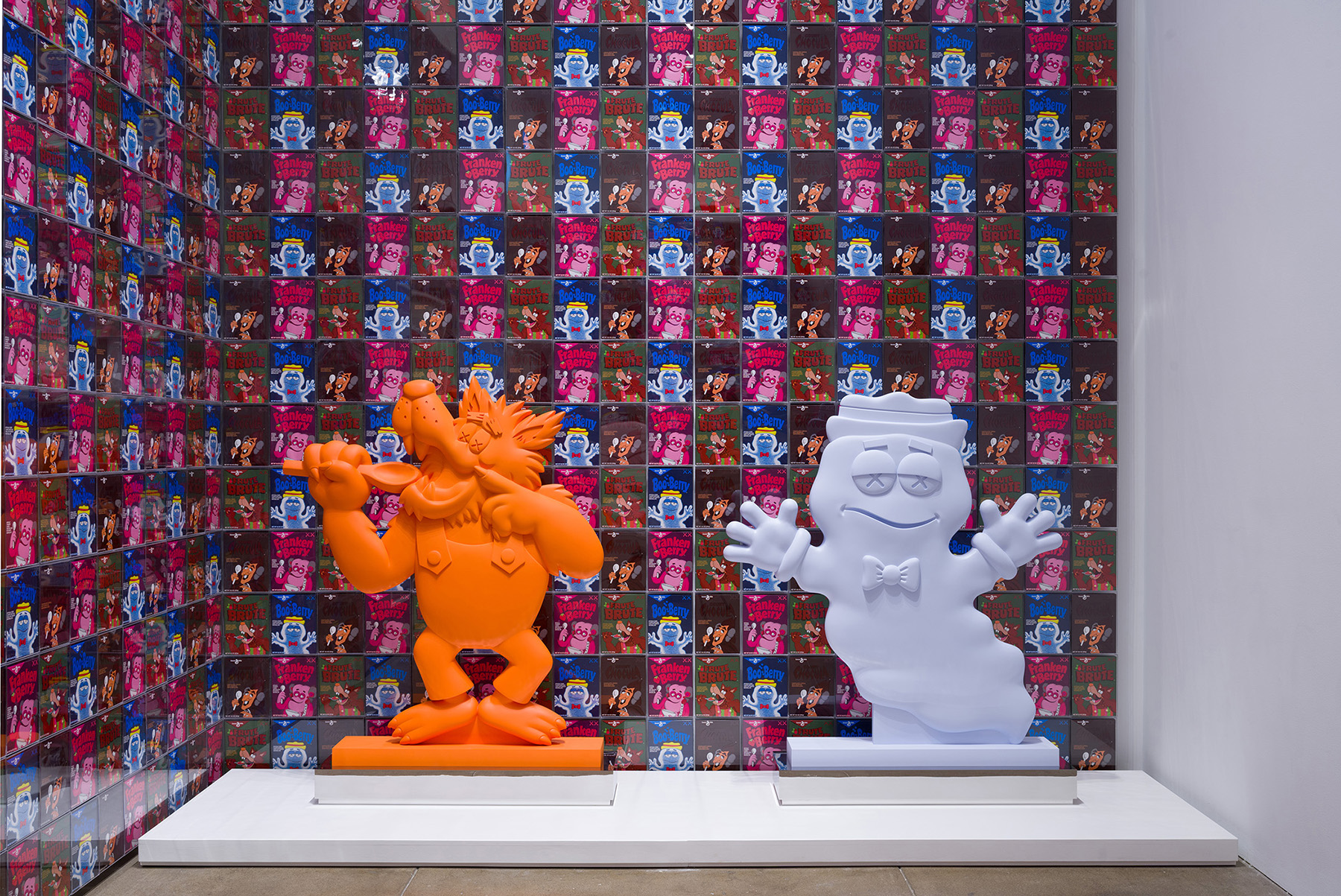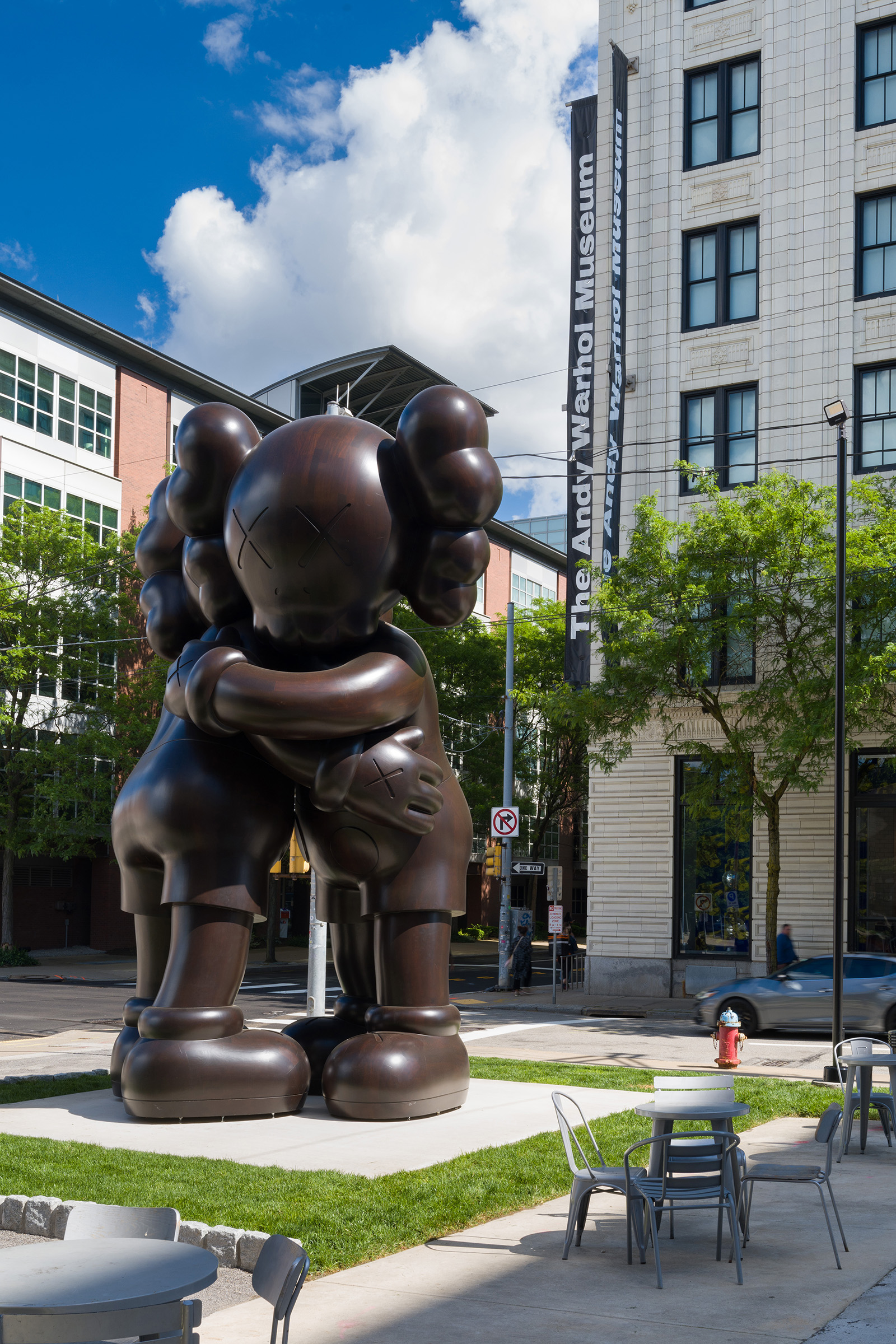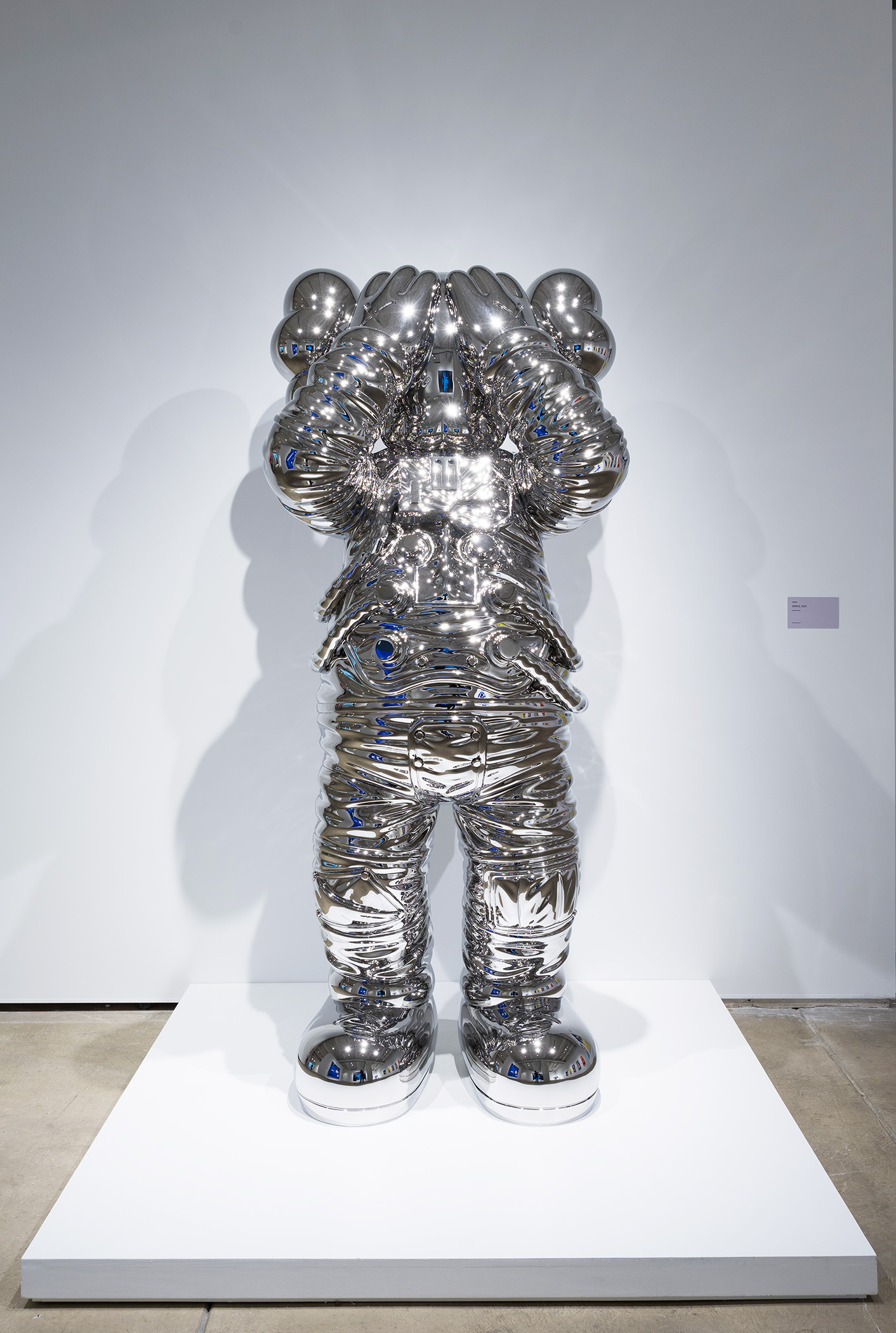‘KAWS + Warhol’ Exhibit Showcases Legendary Pop Artists
The Pittsburgh art exhibit pairs KAWS’ sculptures and paintings with iconic Andy Warhol works.

Andy Warhol’s hometown has gone all in on KAWS. Tastemakers from rapper Pusha T to artist Matt Gondek descended on Pittsburgh on May 17 to celebrate the unveiling of “KAWS + Warhol” at the Andy Warhol Museum. DEVO played after dinner at the gala for the museum’s 30th anniversary the next night, and a monumental public sculpture and mural outside the exhibition drew visitors all weekend.
Comparisons between the pop-culture appropriation of KAWS and Warhol are abound in the art world, but this show’s the first to chart the “dark themes” that proliferate both artists’ work. Further comparisons—and contrasts—between their places within art history emerge as well.
KAWS co-curated the exhibition with the Andy Warhol Museum’s Director Patrick Moore—his final effort for the institution before he steps down on May 31. Moore conceived of the show’s premise after seeing a KAWS show at Skarstedt Gallery in New York three years ago. There, Moore was struck to find the works teeming with enthusiastic fans, many of them teenagers.

KAWS wrote graffiti with legends and helped pioneer street art by vandalizing fashion billboards in New York during the ’90s. Today, his artwork has reached millions through collectibles, sneakers, and high-profile album covers.
KAWS told Maxim he favored The Smiths during his youth, calling his early tastes “kind of emo.” But KAWS would go on to collaborate with some of the hottest hip-hop acts of the 2010s, creating the album art for Kanye West’s 808s and Heartbreaks and designing the visual identity around Kid Cudi’s Man on the Moon boxset.
His latest show opposite Warhol, “KAWS + Warhol,” plays out thematically across two floors, pairs KAWS’ vivid paintings and emotive sculptures with Warhol works spanning paintings, prints, and even a film titled “Blow Job”—which reflects in the glass frames of two close-cropped portraits of KAWS’ “KAWSbob” character.
The central spectacle anchoring the exhibition, however, situates a 2020 edition of KAWS’ iconic “COMPANION” character prone before Warhol’s diptych “Ambulance Disaster” (1963-64)—a silkscreen depicting what it says, in morbid detail. Electric chairs and more car wrecks appear later across the sections “Nostalgia,” “Anxiety,” “Abstraction,” and “Advertising.”

Moore believes the palpable melancholy behind KAWS’ loveable characters and vivid paintings draws crowds to his work just as much as the recognizable imagery KAWS uses.
“We are definitely in a melancholy time,” KAWS said, adding that personal experience also informs his work. KAWS discovered even more about his own artwork by fleshing out the comparisons to Warhol. In his five-part acrylic painting “Soft Turn” (2020), Elmo and KAWS’ Chum character bust out from the canvas atop each other with each successive installment.
Those hang opposite Warhol’s “Myths” series of 1981, translating legends like Mickey Mouse and Uncle Sam through his famed eye. They all surround “Flowers” (1964). “That wasn’t in my mind at all when I was doing that work,” KAWS said of the hang, yet somehow, “it almost feels like it’s deliberate.”
Elsewhere, alongside KAWS’ colorful abstractions and a Snoopy silhouette titled “ISOLATION TOWER (MBF)” (2015), Warhol’s camouflage prints of 1987 look like original KAWS paintings.

As a counterweight, the show’s lighter second floor highlights “Commerce And Play.” Warhol’s Brillo boxes from the 1960s beckon guests into a cereal installation that KAWS staged by paneling a gallery with thousands of (full) cereal boxes from his recent work with General Mills.
KAWS has admitted that Warhol inevitably entered his artwork early on through osmosis. What’s more, Warhol helped forge the culture that KAWS has contended with his whole career. KAWS might be the most well-known artist alive, but, unlike Warhol, he doesn’t consider fame a big part of the game.
“I want the communication, I want the dialogue with people,” he said. “I love projecting work into the world. If I can go unnoticed as a person, that would be my preference.”

Still, KAWS came from graffiti—a competitive sport based on clout. And, like Warhol, KAWS’ famous friends elevate his acclaim. KAWS even makes a rare appearance in this show, with a painted bronze sculpture of his severed head that sits by an iconic blue self portrait Warhol captured of himself with dramatic silver hair in the ’80s after signing with Zoli modeling agency.
Despite his enigma, KAWS maintains a big boundary between himself and his practice. Placing his work alongside Warhol, who fashioned himself into a star, highlights KAWS’ vulnerability.
Art aficionados certainly have a lot to say about both artists. People love to hate on the two of them. The chatter doesn’t keep KAWS up—he’s busy with a revolving door of museum shows at The Parrish Art Museum in the Hamptons and The Drawing Center in New York this year. Another KAWS museum show in Bentonville, Arkansas is also slated to open in 2025.

At this weekend’s star-studded opening, a trustee told KAWS she’d had reservations about his work before seeing it in person at his first show in Pittsburgh. The Pop District paid for the sculpture outside with the last of their public art budget, which has invested $1 million across six projects thus far. KAWS’ blessing is a status symbol.
KAWS + Warhol will remain open through January 20, 2025.
